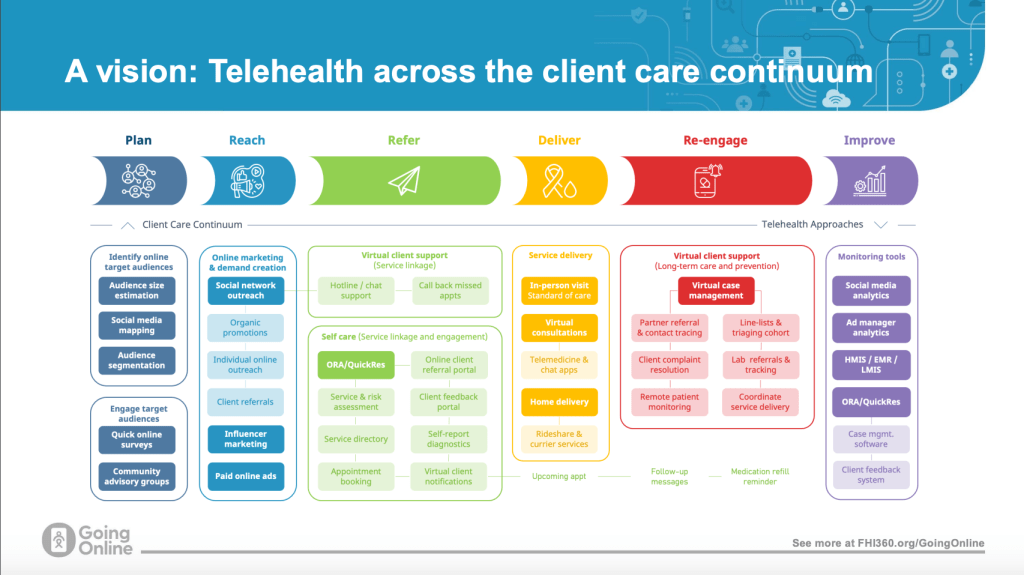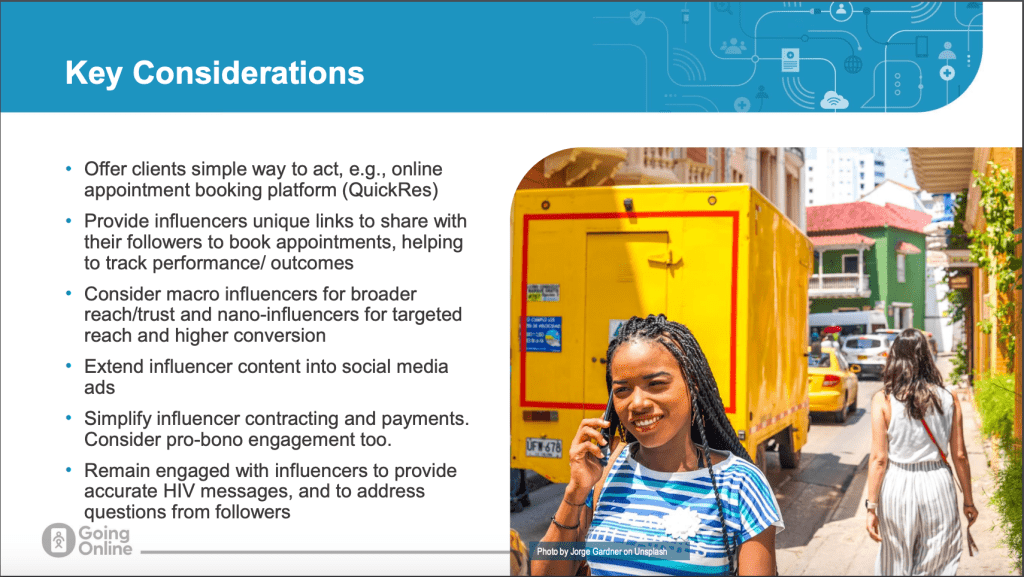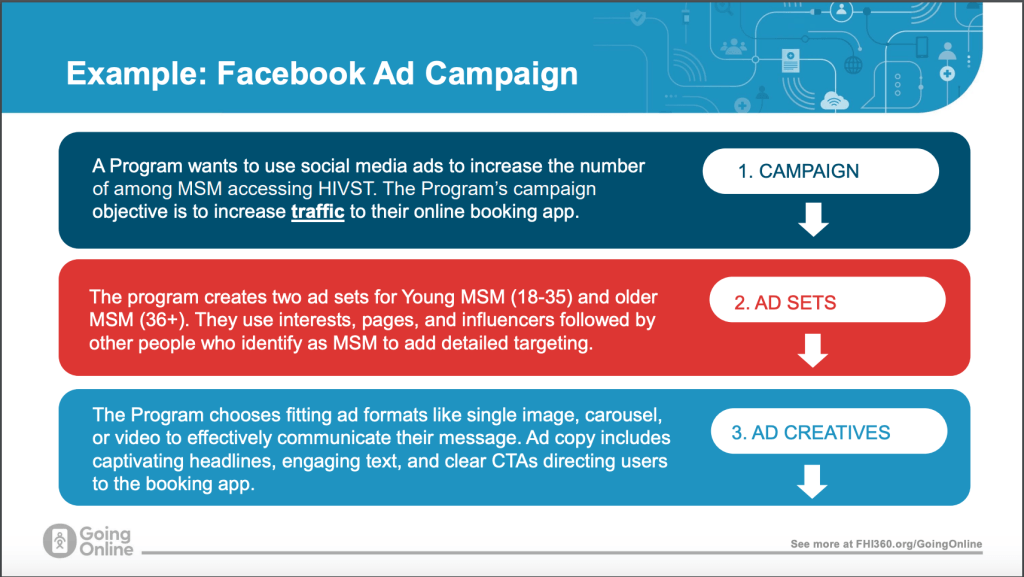Also available in: Español
Source: corresponsalesclave.org
By: Constanza Armas
On May 11, the LAC Platform – Via Libre, with support from the Global Fund to Fight AIDS, Tuberculosis and Malaria (Global Fund) and the human development organization FHI 360, held a webinar to share theoretical and practical information on how to use social networks to create demand for and improve access to HIV services in Latin America and the Caribbean.
The meeting featured several speakers from FHI 360. The first speaker, Shanthi Noriega, Technical Advisor for Telehealth at FHI 360, provided a global overview of the potential of using social networks as a tool to improve access to health services. She noted that many of the gaps that existed years ago in the use of the Internet and social networks are closing. However, disparities in access remain between men and women and between rural and urban areas.
Latin America and the Caribbean stand out in the use of social networks and access to web media, with 51% of users in the Caribbean, 71% in South America, 68% in Central America and 74% in North America; all of these regions, except the Caribbean, are above the global average of 59.4%. Contrary to global measures, the use of networks is higher among women than among men, which, according to the presenter, represents a huge “opportunity to involve them and include them in the programs“.
With this important contextual information, Ben Eveslage, Technical Associate Director for Telehealth at FHI 360, commented on the framework and took a more theoretical approach to the topic. Specifically, he suggested a model based on the cascade of HIV services that can be used as a map for working and “creating a more comprehensive pathway to the services they provide,” referring to the people who work in care sites.

He began by mentioning a key element that was echoed by all the other speakers: the identification of the online target audiences, which will depend on each program or project (Plan). Next, he recommended the use of marketing tools to segment and reach this population (Reach), and offer support and self-care (Refer) through the provision of services (Deliver) and case management (Re-Engage). Finally, and very importantly, he emphasized the use of monitoring tools (Improve).
In general, Eveslage explained, the categories of demand generation are: social media outreach to promote content and information; social influencer outreach, which involves engaging referrers or “people who already work in social media” to build trust with people who use or will use HIV services; and social profile outreach, which is driven by the use of online managers and advertising to target and deliver content to sites and apps used by the target audience.
In this context, the speaker mentioned the Online Reservation and Case Management App (ORA), which has been very helpful in improving healthcare services in various countries around the world. The app is user-friendly for clients, providers, and case and program managers, and makes it easy to track demand generation results. In the 45 countries where it has been implemented, ORA tracks and expands health services, offers both country specific and multi-country approaches, and provides data security and confidentiality.
The application can be used online and works with the logic of the client care continuum, assessing health needs, booking services and tracking data. It can be contracted directly, with no licensing costs, only the cost of technical support from FHI.

From a more practical perspective, Danny Simmonds, Technical Advisor for Telehealth at FHI 360, shared various experiences with demand creation techniques, such as IFLEX in Jamaica, created by the Children First agency. This program provides essential health information to improve support services for men.
In this experience, online outreach workers are trained to identify clients, engage them in prevention messaging, and support them in accessing services. This 1:1 engagement begins through chat, phone calls, or social networking. For enrollment, they use the My Health JA app (which incorporates the ORA app), which allows them to book HIV testing appointments, facilitate follow-up, referrals, and rescheduling, and track their clients for future repeat services. Similarly, the IFLEX initiative uses organic content on social networks, live polls, and Instagram and Facebook stories. Among the key results, Simmonds noted that between October 2021 and September 2022, one in five clients were tested for HIV and syphilis at various locations, and 57% of users expressed acceptance of the service.
Another best practice is QuickREs in Guyana, which employed social influencers to generate demand. Through simple work contracts, various local comedians created short videos and mentions on social networks such as Tik Tok, Facebook, and Instagram, increasing the app’s traffic by 40% a month after implementation.
In the same spirit, the Updatestatus program in Indonesia expanded its campaign to include influencers since 2018. A unique feature of this practice, which proved to be very positive, was the involvement of creative agencies to help create videos for different audiences. The results included a 58% increase in searches for HIV cases and a 23% increase in searches for testing.

The final speaker was Thato Kasongo, a consultant for Telehealth at FHI 360, who spoke about the usefulness of Facebook Ads Manager, a unified platform that allows for easy-to-use campaigns based on audience, ad organization and ad creatives. The Engage Men’s Health initiative in South Africa, for example, uses this tool to target men between the ages of 18 and 55 in Johannesburg.
Kasongo reiterated the importance of taking the time to plan the interventions to be implemented and to “accurately identify the target population”. In this regard, he emphasized that preparation, organization, training of outreach staff, and the involvement of a community advisory group are key factors in implementing any of the interventions that focus on generating demand for HIV care services.
This dynamic, useful and refreshing meeting was of great value to regional organizations working hard in the HIV response. To watch the webinar video, click here.
